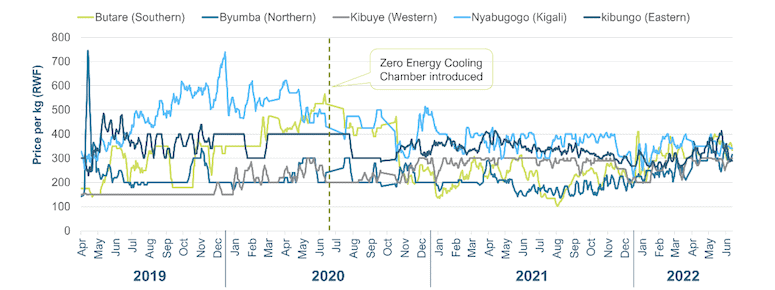Unlocking Data-Driven Policymaking: A Digitalisation Programme in Rwanda Shows the Impact of Improved Storage on Agriculture Prices — And the Value of Digital Data
Transporting produce in Rwanda is difficult — it isn’t called the land of a thousand hills for nothing, and the roads in rural areas are largely unpaved and often in poor condition. In addition, the country’s storage infrastructure is limited. And while there has been progress in expanding the road network and storage facilities, challenges in the transportation of produce remain.
This is particularly true as cold storage traditionally requires electricity — something that 39% of Rwandan households lack. These logistical issues result in farmers either selling their produce cheaply or losing it to spoilage. In addition to less income, the short shelf-life of some produce also means that farmers have infrequent income, making financial planning and saving difficult.
To better understand these challenges and their potential solutions, Cenfri has been analysing the country’s agriculture sector as part of the Rwanda Economy Digitalisation Programme. This is a three-year initiative we’re conducting, in partnership with the Government of Rwanda’s Ministry of Information Technology and Communication and funded by the Mastercard Foundation, to support data-led decision-making in government. (While the three years end in March 2024, discussions for an extension are ongoing.)
To understand how the agriculture sector is performing, we analysed the performance of the Ministry of Agriculture and Animal Resources (MINAGRI)’s priority crops using data from eSoko. MINAGRI established the eSoko platform to help inform farmers of the prevailing market prices of their produce, as part of Rwanda’s efforts to advance the digitalisation of its economy. The platform does this by equipping field staff with smart phones to collect pricing information for a range of agricultural commodities from over 60 markets across Rwanda. Prices from this database are then regularly shared with farmers via digital channels.
We used this data, along with additional underlying data that showed the prices of these crops at a greater level of granularity, to explore the impacts of inflation, seasonality, price stability and regional differences on the prices of priority crops. In the process, we found an interesting anomaly in carrot prices that we were able to explain with further analysis. This analysis revealed how digitalisation can enable a clearer understanding of the impact policy and support initiatives have on markets. With a sound understanding of a market’s performance, support initiatives can ensure that relevant interventions are undertaken and their impacts tracked, to create well-functioning markets with predictable prices that allow farmers to plan ahead and receive fair value for the goods they produce.
Effective post-harvest management empowers farmers to make supply decisions
In the graph below, we show the prices of carrots — one of MINAGRI’s priority crops — in five markets from each of the Rwandan provinces from April 2019 to June 2022.

Figure 1: Farmer prices for carrots across regions 2019-2022
Source: eSoko MINAGRI
Between April 2019 and June 2020, we see large price differences across markets: For instance, prices are often double, or even more, in Kigali compared to other regions. This suggests there are shortages in some markets, while others need to drop the price on excess produce to get rid of stock before it spoils. But after June 2020, we see the differences in prices decreasing and becoming more similar across regions, indicating more stable and predictable markets. This change can also be measured using the standard deviation of price, a statistical measure of how much prices vary from the mean. Before June 2020, the standard deviation was 145 Rwandan francs. After June 2020 it declined to 81 francs, demonstrating considerably less variation in prices.
As indicated in the graph, this price stabilisation coincided with the implementation of a new storage solution — the Zero Energy Cooling Chamber — in June 2020. Thanks to this facility, farmers are now better able to store carrots when they are in oversupply and send them to regions where there are shortages. Storage is, of course, only part of the logistics of getting perishable foods to market on time and in good condition. But this facility has nonetheless played a valuable role in stabilising prices for Rwandan produce.
This innovation was implemented under the USAID-funded Hinga Weze project in the Western Province, and it provided KOGIMUIN — a 55-member farmer cooperative — with a facility that houses 300 crates of carrots of 15 kg each. The Zero Energy Cooling Chamber utilises no electricity, relying only on the simple thermodynamics of bricks, water and sand to maintain carrots at cool temperatures. When harvests are greater than the Zero Energy Cooling Chamber’s capacity, cold rooms are utilised.
The facility was provided alongside broader training on post-harvest handling techniques, which has enabled farmers to store their carrots for up to five months, helping them to stabilise the supply available on the market. These improved post-harvest management techniques were also linked with support on market access, a combination of interventions that have allowed farmers to negotiate better prices — amounting to 50% increases in some instances.
It is important to note that shortly prior to the interventions by Hinga Weze, Rwanda experienced a national COVID-19 lockdown starting in mid-March of 2020. If this had been a key driver of the change in price, we would observe a similar change in the prices of other crops. However, other crops did not show a similar variation during this period. This suggests that the national lockdown was not a driver of the trend we see here.
Making price data useful to farmers and policymakers
The aim of eSoko is to make prices easily accessible, and thereby help make markets more efficient by ensuring that farmers are well-informed of where their produce will receive the best price. However, this information is only useful if farmers can access the different markets. Otherwise, they may still have to sell crops cheaply or lose them to spoilage, regardless of whether better prices are available at other markets. But if farmers don’t need to deliver to the local market right away, the differences in prices across markets can more directly reveal the true costs of transport and logistics. These price differences should narrow as logistics improve and lower the costs of shifting production to different markets in Rwanda.
The impact of improved storage and logistics on Rwandan farmers can only be seen and understood because the price data can be linked to events or interventions occurring during the data review period. Thanks to data scientists Cenfri trained and placed within MINAGRI, we were able to access the data from eSoko for the above analysis. Going forward, these scientists are also working to ensure that the eSoko data is accessible to the relevant government departments, to allow them to better understand the impact of their policies on agriculture markets in near real-time.
Rwanda has invested significantly in the digitalisation of its economy through various programmes, such as the eSoko system that provided the data analysed in this article. These investments have made it possible to obtain data that highlights the impacts of policy and initiatives on markets. The challenge is getting this data to policymakers promptly, in a format they understand. It is only by doing so that we can unlock data-driven policymaking in Rwanda and other emerging economies — a challenge we are working on through the Rwanda Economy Digitalisation Programme.
Olivia Rutayisire is a Data Scientist, and Pieter Janse van Vuuren is an Associate at Cenfri.
Photo courtesy of IFPRI/Ian Masias.
- Categories
- Agriculture, Technology



